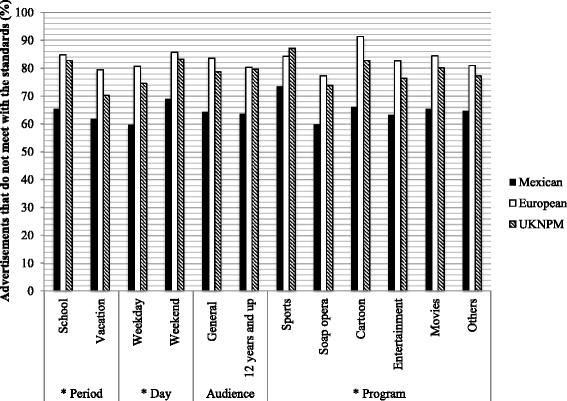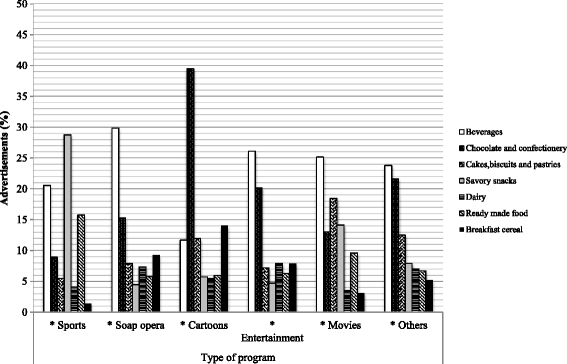Nutritional quality of foods and non-alcoholic beverages advertised on Mexican television according to three nutrient profile models
- PMID: 27495000
- PMCID: PMC4975920
- DOI: 10.1186/s12889-016-3298-0
Nutritional quality of foods and non-alcoholic beverages advertised on Mexican television according to three nutrient profile models
Abstract
Background: Evidence supports that television food advertisements influence children's food preferences and their consumption. However, few studies have examined the extent and nature of food marketing to children in low and middle income countries. This study aims to assess the nutritional quality of foods and beverages advertised on Mexican TV, applying the Mexican, World Health Organization (WHO) European and United Kingdom (UKNPM) nutrient profile models, before the Mexican regulation on food marketing came into effect.
Methods: We recorded 600 h on the four national public and free TV channels with the highest national ratings, from December 2012 to April 2013. Recordings were done for 40 randomly selected (week, weekend, school and vacation) days, from 7 am to 10 pm. Nutritional information per 100 g/ml of product was obtained from the product labels or company websites.
Results: A total of 2,544 food and non-alcoholic beverage advertisements were broadcast, for 275 different products. On average, the foods advertised during cartoon programming had the highest energy (367 kcal) and sugar (30.0 g) content, while foods advertised during sport programming had the highest amount of total fat (9.5 g) and sodium (412 mg) content. More than 60 % of the foods advertised did not meet any nutritional quality standards. 64.3 % of the products did not comply with the Mexican nutritional standards, as compared with 83.1 % and 78.7 % with WHO Europe and UKNPM standards, respectively. The food groups most frequently advertised were beverages (24.6 %), followed by chocolate and confectionery sugar (19.7 %), cakes, sweet biscuits and pastries (12.0 %), savory snacks (9.3 %), breakfast cereals (7.1 %), ready-made food (6.4 %) and dairy products (6.0 %).
Conclusion: The majority of foods and beverages advertised on Mexican TV do not comply with any nutritional quality standards, and thus should not be marketed to children. The nutritional quality standards applied by the Mexican regulation are much weaker than those applied by the WHO Europe and United Kingdom. The Mexican government should improve the nutrition standards in its new regulation, especially the sugar cut off points.
Keywords: Advertising; Food and beverages; Mexico; Nutrient profile models; Nutritional content; Television.
Figures



Similar articles
-
Nutritional Quality of Hidden Food and Beverage Advertising Directed to Children: Extent and Nature of Product Placement in Mexican Television Programs.Int J Environ Res Public Health. 2020 Apr 29;17(9):3086. doi: 10.3390/ijerph17093086. Int J Environ Res Public Health. 2020. PMID: 32365478 Free PMC article.
-
Nutritional quality of foods and non-alcoholic beverages advertised on Brazilian free-to-air television: a cross-sectional study.BMC Public Health. 2020 Mar 24;20(1):385. doi: 10.1186/s12889-020-08527-6. BMC Public Health. 2020. PMID: 32209067 Free PMC article.
-
Evaluation of food and beverage television advertising during children's viewing time in Spain using the UK nutrient profile model.Public Health Nutr. 2013 Jul;16(7):1314-20. doi: 10.1017/S1368980012003503. Epub 2012 Jul 27. Public Health Nutr. 2013. PMID: 23174346 Free PMC article.
-
Scoping review of studies on food marketing in Latin America: Summary of existing evidence and research gaps.Rev Saude Publica. 2020 Jan 10;53:107. doi: 10.11606/S1518-8787.2019053001184. eCollection 2020. Rev Saude Publica. 2020. PMID: 31967201 Free PMC article.
-
Challenges and Opportunities for Change in Food Marketing to Children and Youth: Workshop Summary.Washington (DC): National Academies Press (US); 2013 May 14. Washington (DC): National Academies Press (US); 2013 May 14. PMID: 24872975 Free Books & Documents. Review.
Cited by
-
Nutrient profiling assessment of packaged snack foods with nutrition-related claims available on the Indian market.Front Nutr. 2024 Oct 9;11:1425354. doi: 10.3389/fnut.2024.1425354. eCollection 2024. Front Nutr. 2024. PMID: 39444575 Free PMC article.
-
Nutritional Quality of Hidden Food and Beverage Advertising Directed to Children: Extent and Nature of Product Placement in Mexican Television Programs.Int J Environ Res Public Health. 2020 Apr 29;17(9):3086. doi: 10.3390/ijerph17093086. Int J Environ Res Public Health. 2020. PMID: 32365478 Free PMC article.
-
Food environment solutions for childhood obesity in Latin America and among Latinos living in the United States.Obes Rev. 2021 Jun;22 Suppl 3(Suppl 3):e13237. doi: 10.1111/obr.13237. Obes Rev. 2021. PMID: 34152071 Free PMC article. Review.
-
Cross-Sectional Evaluation of Food Items Preferred by Adolescents under the Influence of Television Advertisements.J Res Health Sci. 2021 Dec 28;22(1):e00539. doi: 10.34172/jrhs.2022.74. J Res Health Sci. 2021. PMID: 36511255 Free PMC article.
-
The extent and nature of television food and non-alcoholic beverage advertising to children during chinese New Year in Beijing, China.BMC Public Health. 2022 Jul 26;22(1):1417. doi: 10.1186/s12889-022-13801-w. BMC Public Health. 2022. PMID: 35883126 Free PMC article.
References
-
- Gutiérrez JP,Rivera-Dommarco J,Shamah-Levy T,Villalpando-Hernández S,Franco A,Cuevas-Nasu L,et al.Encuesta Nacional de Salud y Nutrición 2012. Salúd Pública(MX).2012. - PubMed
-
- McGinnis JM, Gootman JA, Kraak VI. Food Marketing to Children and Youth: Threat or Opportunity? Committee on Food Marketing and the Diets of Children and Youth.[Internet]. Institute of Medicine.The National Academies Press; 2006. 536 p. Available from: http://www.nap.edu/catalog/11514.html.
MeSH terms
Substances
LinkOut - more resources
Full Text Sources
Other Literature Sources
Miscellaneous

